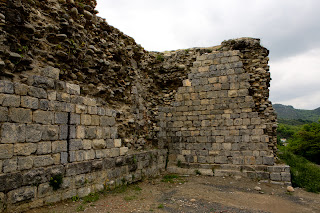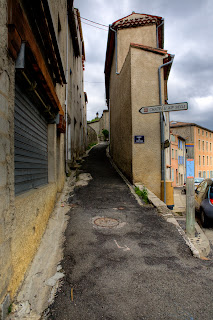On Ascension (May, Thursday), we left Carcassonne for a day trip by an SNCF bus which arrived at its final destination perhaps an hour later--Quillan. This town/village of 3,591 people does not get much space in English tour guides, but it is ideal for anyone interested in hiking on marked trails in the surrounding mountains (foothills to folks from British Columbia) or exploring crafts and local foods and wines, all of which are excellent. We were there on a major holiday, which meant nearly everything was closed. Although France is a post-Christian nation, its citizens take the traditional religious holidays very seriously indeed (as holidays from work). The weather alternated between light rain and threats of rain, but this brought out the beauty of the fresh spring greens in trees and grasses.
Little remains of the 12th-c. Cathar castle perched on the hill overlooking the village and the brisk River Aude fed by mountain streams. The disastrous Albigensian Crusade crushed the economic and cultural fiber of the Languedoc and other southern regions which had somewhat generously tolerated the 10% who were Cathars rather than Catholics. This ultimately meant that the other 90% paid a heavy price indeed for extending religious tolerance. Modern French society still debates religious freedoms, but now while facing immigration of French colonials who take religion seriously.
The ruined castle still has a few lower walls, several openings where sturdy gates once swung, and offers a lovely view of the traffic and village life below. This was possibly the primary gate into the 12th-c fortification, a thick wall, possibly with double gates.
The walls were constructed according to the fashion of the day, by using stone fill with cement for the inner part of the wall and then covering that rough masonry with cut stones, some of which were surely "quarried" from the destroyed edifice and used to construct parts of the town once the townspeople realized the government to the north would never allow the castle to be rebuilt.
Some openings serving as doorways and windows can still be seen, as well as outlines of inner walls for rooms, stables, etc.
Castles are most often situated on high, defensible outcroppings which overlook strategic trade routes and rivers, presumably to exact levies which help pay for the castle upkeep. Ideally, the peasants living below the castles could seek safety and food within the castle during times of hostilities. But water would invariably cause collapse, as would unexpected acts of betrayal, false promises believed, or paralyzing fear from the spectre of overwhelming military odds and certain death unless one surrendered when offered somewhat favourable terms.
The climb to Quillan Castle is not difficult these days, but the narrow road does keep ascending.
The Pont Vieux (Old Bridge) is also from the 12th century. It once had a mill on one side for grinding various types of grain.







